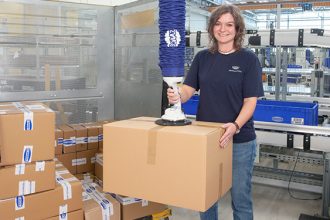Until Automation Does Everything, Protect Your People With Ergonomic Solutions Now

With unemployment at record lows, U.S. manufacturing, distribution and warehousing operations are increasingly evaluating automated material handling equipment as a solution to their ongoing challenges in attracting, hiring and retaining people. Yet, for many small companies, the significant investment required to implement fully automated solutions that can completely eliminate manual handling is financially out of reach. Even large operations making substantial investments in widespread automation within their facilities still need people to handle hundreds of variations and numerous exceptions that the systems cannot efficiently manage. They also will continue to need staffers with the ability to operate, program, maintain and service the automated systems and equipment.
Further, the current U.S. workforce is aging and not as fit as it was 25 years ago. Today, the average age of a worker is 46, and a third of the current population is classified as obese. Likewise, people who are now of an age when previous generations retired are continuing to work, while younger generations are less interested in the types of manual jobs required in material handling operations. With an aging and less fit workforce, the risk of lost time injuries associated with poor ergonomics — caused by repetitive motions, overexertion, strains, reaching, stretching, pushing, pulling, carrying heavy loads, bending and twisting — drastically increases when performing such tasks.
Injuries currently cost U.S. companies more than $94 billion in workers’ compensation costs — 32% of which are attributed to manual material handling activities in manufacturing and warehousing. They also contribute to indirect costs, such as downtime, loss of quality, productivity and efficiency, as well as the need to replace and retrain the injured worker and increased insurance rates. Years ago, ergonomics was a nice thing to do; today it is a must do.
That’s why, whether an operation can afford an investment in automation or not, ergonomic assist equipment helps protect the current workforce (regardless of their age or fitness level) by enabling them to complete tasks with less effort and at higher productivity rates. In general, when compared to fully automated systems, ergonomic assist solutions require a considerably smaller outlay of capital to purchase and implement, are easier to operate, and deliver a measurable return on investment in just a few months.
Here’s an overview of the main types of ergonomic assist solutions available:
Work Positioners: These systems come in a variety of styles to support or elevate the load either from underneath or overhead. They include:
- Lift tables – Portable or stationary, these devices support and lift loads from the bottom up to keep them at the ideal working height for an operator. They may also include a manual turntable to allow the load to spin while the operator remains in the same spot, or a tilting function to enable easier access to the contents of a container, for example.
- Pallet positioners – A type of lift table, usually actuated by a spring or an air bag, that raises or lowers as the pallet is being stacked or unloaded. They can be placed on any level surface.
- Tilters – Equipment that mechanically angles a container, box or bin to give an operator easier access to its contents with less bending, stretching and reaching.
- Manipulators – Stationary or portable mechanical arms with an end-effector attachment (tooling, gripper or forks) that counteracts the weight of the load to eliminate worker strain.
- Balancers – These devices support a load from overhead while the operator maneuvers it up and down and side to side.
- Vacuum lifters – A device using vacuum technology to attach and lift the load (pallets, pails, cartons, cases, oversize or delicate flat surface items) for pick and place tasks.
- Drum turners – Equipment that turns a drum to empty the contents.
- Stackers – Manual or powered lifting devices that move, raise and position loads to comfortable, ergonomic work heights. Mast-supported, the load rides on platforms, adjustable forks or fixed forks. They are often used for pallet handling but differ from forklifts in three ways: the operator does not ride on the unit, they are highly maneuverable in tight quarters, and they are less expensive.
- Skid lifter – Similar to a pallet jack but with forks that raise up to 24 inches. These manual or powered units are used to position open-bottom pallets or skids.
Workstations: A workbench that adjusts up or down to accommodate workers (and work) of various heights. They are often used in assembly and finishing processes, as well as for packing.
Carts: Manually pushed plastic or metal platform that rides on wheels or casters to move items. They can be equipped with drawers, bins, trays or flat surfaces for material transport. Types include dollies, platform trucks, and U-boats. Additionally, they can be outfitted with a mechanical lifting platform self-leveling shelves to raise and lower the load to a comfortable working height. Carts can also be towed by tuggers, either autonomous or manned.
Pallet rotators: Equipment used to exchange pallets without unstacking the load. This enables the replacement of a damaged pallet, switchover to a preferred internal-use pallet, or removal of damaged products from the bottom of the stack.
Hand trucks: Similar to a two-wheeled dolly, powered hand trucks can raise and lower the load for easier, more ergonomic handling by the operator.
Roller rack: Inserted into standard pallet rack, these roller devices use gravity to impel a carton to the pick face as the one ahead of it is removed, eliminating reaching and stretching.
Extendible conveyor: Usually located at the dock, these accordion style conveyors can be extended into the back of a trailer to facilitate manual loading and unloading of floor loaded cartons, cutting operator walk time.
As with most material handling challenges, there are numerous possible equipment solutions available to address the same ergonomic problem. Want more ideas for improving the safety and efficiency of your workforce? The members of the Ergonomic Assist Systems & Equipment (EASE) Industry Group of MHI are available to consult, answer questions and make recommendations. Additionally, EASE has produced a video on this topic, here.



